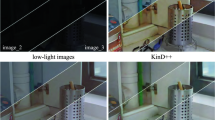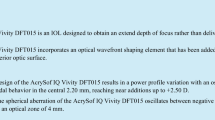Abstract
In the real world, the index of refraction of a refractive object (caustic object) varies across the wavelengths. Therefore, in physically based caustic rendering, we need to take into account spectral information. However, this may lead to prohibitive running time. In response, we propose a two-step acceleration scheme for spectral caustic rendering. Our acceleration scheme takes into account information across visible wavelengths of the scene, that is, the index of refraction (IOR) (caustic object), light power (light), and material reflectance (surface). To process visible wavelengths effectively, firstly we cluster the wavelengths which have similar first refraction (air to caustic object) directions. In this way, all the wavelengths in a cluster can be represented by one light ray during rendering. Secondly, by considering the surrounding objects (their material reflectance from and visible surface area of the caustic objects) and light power, we compute the refinement amount of each wavelength cluster. Our accelerated algorithm can produce photorealistic rendering results close to their reference images (which are generated by rendering every 1 nm of visible wavelengths) with a significant acceleration magnitude. Computational experiment results and comparative analyses are reported in the paper.














Similar content being viewed by others
References
Lai, G., Christensen, N.: A compression method for spectral photon map rendering. In: 15th International Conference in Central Europe on Computer Graphics, Visualization and Computer Vision 2007, WSCG’2007 - In Co-operation with EUROGRAPHICS, Full Papers ProceedingsWSCG Proceedings, pp. 95–102. Plzen (2007)
Hachisuka, T.: Toshiya Hachisuka at UTokyo http://www.ci.i.u-tokyo.ac.jp/hachisuka/
Hachisuka, T., Jensen, H.W.: Stochastic progressive photon mapping. ACM Trans. Graph. 28(5), 141:1–141:8 (2009)
Useful color data. http://www.cis.rit.edu/research/mcsl2/online/cie.php
Frisvad, J.R., Christensen, N.J., Jensen, H.W.: Computing the scattering properties of participating media using lorenz-mie theory. ACM Trans. Graph. 26(3) (2007). doi:10.1145/1276377.1276452
Gutierrez, D., Seron, F.J., Munoz, A., Anson, O.: Visualizing underwater ocean optics. Comput. Graph. Forum 27(2), 547–556 (2008). doi:10.1111/j.1467-8659.2008.01152.x
Guy, S., Soler, C.: Graphics gems revisited: fast and physically-based rendering of gemstones. ACM Trans. Graph. 23(3), 231–238 (2004). doi:10.1145/1015706.1015708
Wright, W.D.: A re-determination of the trichromatic coefficients of the spectral colours. Trans. Opt. Soc. 30(4), 141 (1929)
Jensen, H.W.: Global illumination using photon maps pp. 21–30 (1996)
Johnson, G., Fairchild, M.: Full-spectral color calculations in realistic image synthesis. IEEE Comput. Graph. Appl. 19(4), 47–53 (1999)
Radziszewski, M., Boryczko, K., Alda, W.: An improved technique for full spectral rendering. J. WSCG 17(1–3), 9–16 (2009)
Shi, J., Zhu, D., Zhang, Y., Wang, Z.: Realistically rendering polluted water. Vis. Comput. 28(6–8), 647–656 (2012). doi:10.1007/s00371-012-0685-0
Dong, W.: Rendering optical effects based on spectra representation in complex scenes. In: Nishita, T., Peng, Q., Seidel, H.-P. (eds.) Advances in Computer Graphics. Lecture Notes in Computer Science, vol. 4035, pp. 719–726. Springer, Berlin Heidelbeg (2006)
Gondek, J.S., Meyer, G.W., Newman, J.G.: Wavelength dependent reflectance functions. Proceedings of the 21st annual conference on Computer graphics and interactive techniques. SIGGRAPH ’94, pp. 213–220. ACM, New York, NY, USA (1994)
Hirayama, H., Kaneda, K., Yamashita, H., Yamaji, Y., Monden, Y.: Visualization of optical phenomena caused by multilayer films with complex refractive indices. In: Computer graphics and applications, 1999. Proceedings. Seventh Pacific Conference on, pp. 128–137, 320 (1999)
Sun, Y., Fracchia, F., Calvert, T., Drew, M.: Deriving spectra from colors and rendering light interference. Comput. Graph. Appl. IEEE 19(4), 61–67 (1999)
Iwasaki, K., Matsuzawa, K., Nishita, T.: Real-time rendering of soap bubbles taking into account light interference. In: Proceedings of the Computer graphics international, pp. 344–348. IEEE Computer Society (2004)
Durikovič, R., Kimura, R.: Spectrum-based rendering using programmable graphics hardware. In: Proceedings of the 21st spring conference on Computer graphics, pp. 233–236. ACM, Budmerice, Slovakia (2005)
Durikovic, R., Kimura, R.: GPU rendering of the thin film on paints with full spectrum. In: Information visualization, 2006. IV 2006. Tenth International Conference on, pp. 751–756 (2006)
Sun, Y.: Rendering biological iridescences with RGB-based renderers. ACM Trans. Graph. 25(1), 100–129 (2006)
Sun, Y., Wang, Q.: Interference shaders of thin films. Comput. Graph. Forum 27, 1607–1631 (2008)
Stam, J.: Diffraction shaders. In: Proceedings of the 26th annual conference on Computer graphics and interactive techniques, pp. 101–110. ACM Press/Addison-Wesley Publishing Co. (1999)
Agu, E.O.: Diffraction shading models in computer graphics. Ph.D. thesis, University of Massachusetts Amherst (2001)
Imura, M., Abe, T., Kanaya, I., Yasumuro, Y., Manabe, Y., Chihara, K.: Rendering of Play of color using stratified model based on amorphous structure of opal. Techniques and Applications, Proceedings VIIth Digital Image Computing (2003)
Wu, J., Zheng, C., Hu, X., Xu, F.: Rendering realistic spectral bokeh due to lens stops and aberrations. Vis. Comput. 29(1), 41–52 (2013). doi:10.1007/s00371-012-0673-4
Musgrave, F.K.: Prisms and rainbows: a dispersion model for computer graphics. Proc. Graph. Interface 89, 227–234 (1989)
Sadeghi, I., Munoz, A., Laven, P., Jarosz, W., Seron, F., Gutierrez, D., Jensen, H.W.: Physically-based simulation of rainbows. ACM Trans. Graph. 31(1), 3:13:12 (2012). doi:10.1145/2077341.2077344
Xing, X., Dong, W., Zhang, X., Paul, J.C.: Spectrally-based single image relighting. In: Proceedings of the Entertainment for education and 5th international conference on E-learning and games, Edutainment’10, pp. 509–517. Springer, Berlin, Heidelberg (2010)
Bergner, S., Mller, T., Drew, M.S., Finlayson, G.D.: Interactive spectral volume rendering. In: Proceedings of the conference on Visualization ’02, pp. 101–108. IEEE Computer Society, Boston, Massachusetts (2002)
Strengert, M., Klein, T., Botchen, R., Stegmaier, S., Chen, M., Ertl, T.: Spectral volume rendering using GPU-based raycasting. Vis. Comput. 22(8), 550–561 (2006)
Marimont, D.H., Wandell, B.A.: Linear models of surface and illuminant spectra. J. Opt. Soc. Am. A 9(11), 1905–1913 (1992)
Chern, J.R., Wang, C.M.: A novel progressive refinement algorithm for full spectral rendering. Real Time Imaging 11(2), 117–127 (2005)
Rougeron, G., Proche, B., Lisse, C.S.: An adaptive representation of spectral data for reflectance computations. In: Eurographics Rendering Workshop, pp. 127–138. Springer (1997)
Xu, H., Sun, Y.: Compact representation of spectral BRDFs using fourier transform and spherical harmonic expansion. Comput. Graph. Forum 25(4), 759–775 (2006)
Zeghers, E., Carr, S., Bouatouch, K.: Error-bound wavelength selection for spectral rendering. Vis. Comput. 13(9–10), 424–434 (1998)
Iehl, J., Proche, B.: Adaptive spectral rendering with a perceptual control. Comput. Graph. Forum 19(3), 291–299 (2000)
Meyer, G.W.: Wavelength selection for synthetic image generation. Comput. Vis. Graph. Image Process. 41(1), 57–79 (1988)
Deville, P.M., Merzouk, S., Cazier, D., Paul, J.C.: Spectral data modeling for a lighting application. Comput. Graph. Forum 13(3), 97–106 (1994)
Sun, Y., Fracchia, F.D., Drew, M.S.: A composite spectral model and its applications. pp. 102–107 (2000)
Sun, Y., Fracchia, F.D., Drew, M.S., Calvert, T.W.: A spectrally based framework for realistic image synthesis. Vis. Comput. 17(7), 429–444 (2001)
Evans, G.F., McCool, M.D.: Stratified wavelength clusters for efficient spectral monte carlo rendering. In: Proceedings of the 1999 conference on Graphics interface ’99, p. 42–49. Morgan Kaufmann Publishers Inc., San Francisco, CA, USA (1999)
Iehl, J., Proche, B.: Towards perceptual control of physically based spectral rendering. Comput. Graph. (Pergamon) 27(5), 747–762 (2003)
Smits, B.: An RGB-to-spectrum conversion for reflectances. J. Graph. Tools 4(4), 11–22 (1999)
Wallis, R.: Fast computation of tristimulus values by use of gaussian quadrature. J. Opt. Soc. Am. 65(1), 91–94 (1975)
Boulos, S., Edwards, D., Lacewell, J.D., Kniss, J., Kautz, J., Shirley, P., Wald, I.: Packet-based whitted and distribution ray tracing. In: Proceedings of Graphics Interface 2007, GI ’07, p. 177–184. ACM, New York, NY, USA (2007). doi:10.1145/1268517.1268547
Elek, O., Bauszat, P., Ritschel, T., Magnor, M., Seidel, H.P.: Spectral ray differentials. Computer Graphics Forum (Proceedings of EGSR) 33(4) (2014)
Schjøth, L., Frisvad, J.R., Erleben, K., Sporring, J.: Photon differentials. In: Proceedings of the 5th international conference on Computer graphics and interactive techniques in Australia and Southeast Asia, pp. 179–186. ACM, Perth, Australia (2007). doi:10.1145/1321261.1321293
Wyman, C., Davis, S.: Interactive image-space techniques for approximating caustics. In: Proceedings of the 2006 symposium on Interactive 3D graphics and games, pp. 153–160. ACM, Redwood City, California (2006). doi:10.1145/1111411.1111439
Devlin, K., Chalmers, A., Wilkie, A., Purgathofer, W.: STAR: Tone reproduction and physically based spectral rendering. In: D. Fellner, R. Scopignio (eds.) State of the Art Reports, Eurographics 2002, pp. 101–123. The Eurographics Association (2002)
Downloads | SCHOTT north america. http://www.us.schott.com/advanced_optics/english/download/index.html
Weidlich, A., Wilkie, A.: Anomalous dispersion in predictive rendering. Comput. Graph. Forum 28(4), 1065–1072 (2009)
NVIDIA OptiX ray tracing engine. http://developer.nvidia.com/optix
Acknowledgments
This work is partially supported by a research grant MOE2011-T2-2-037 from Ministry of Education, Singapore. Henry Johan is supported by Fraunhofer IDM@NTU, which is funded by the National Research Foundation (NRF) and managed through the multiagency Interactive & Digital Media Programme Office (IDMPO) hosted by the Media Development Authority of Singapore (MDA).
Author information
Authors and Affiliations
Corresponding author
Rights and permissions
About this article
Cite this article
Tandianus, B., Johan, H., Seah, H.S. et al. Spectral caustic rendering of a homogeneous caustic object based on wavelength clustering and eye sensitivity. Vis Comput 31, 1601–1614 (2015). https://doi.org/10.1007/s00371-014-1037-z
Published:
Issue Date:
DOI: https://doi.org/10.1007/s00371-014-1037-z




